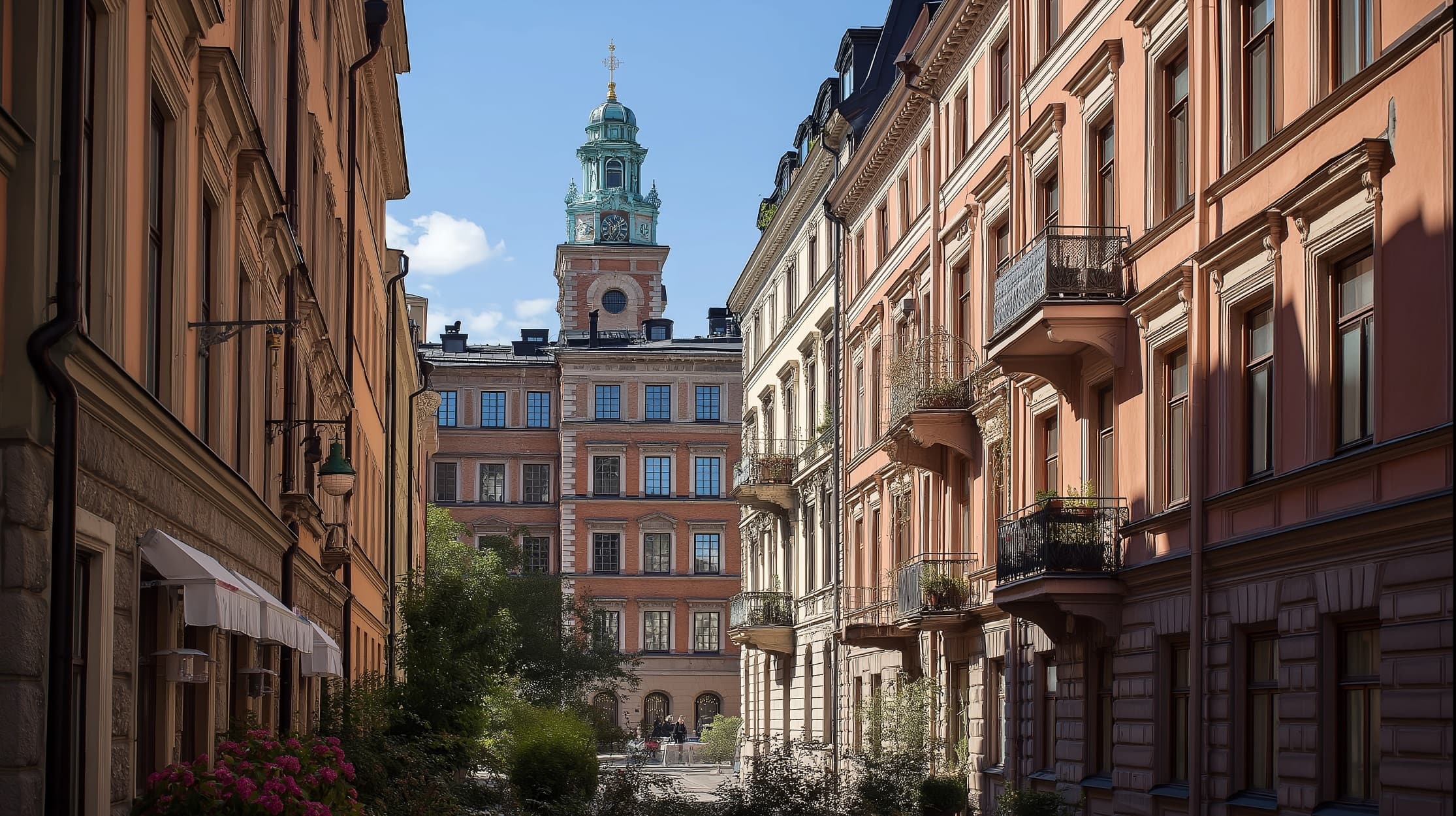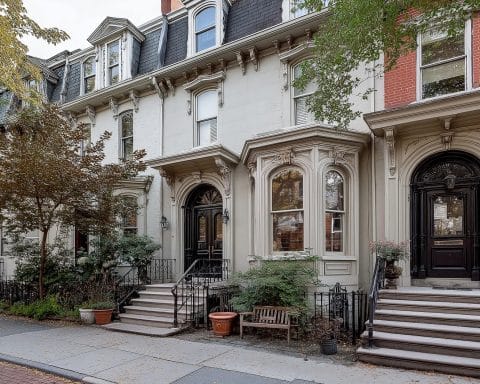Stockholm’s real estate market in 2025 stands at a pivotal juncture, characterized by a cautious recovery in housing prices, evolving office space needs, and robust urban development plans. The following report provides a comprehensive overview of the market’s key segments and influencing factors, from residential and commercial trends to policy shifts and macroeconomic drivers.
Residential Real Estate Trends
Stockholm’s housing market is rebounding in 2025 after a notable downturn in 2022–2023. Home prices in Greater Stockholm have returned to modest growth: the house price index rose about +2.3% year-on-year in Q1 2025 (after slight gains in late 2024) globalpropertyguide.com. This follows a sharp correction when values fell ~16% from their peak during 2022–2023 investropa.com – the steepest decline since the early 1990s. Improved buyer sentiment and stabilizing interest rates have helped turn the tide: most forecasts predict Swedish property prices will rise by 2–5% in 2025 amid recovering sales activity and buyer confidence globalpropertyguide.com. In fact, nationwide home sales jumped +13.2% in 2024 (after double-digit drops in 2023), and sales in Q1 2025 are up another +14.6% year-on-year, indicating demand is bouncing back strongly globalpropertyguide.com. Apartments are leading the recovery – values of flats in urban areas are up nearly 5% year-on-year in early 2025, outpacing the ~3% growth for detached houses investropa.com investropa.com. Notably, smaller units in trendy inner-city districts like Södermalm and Vasastan are especially in demand, attracting young professionals and investors despite recent volatility investropa.com.
Demand–supply dynamics are shifting as well. With the Swedish Riksbank reversing course and cutting interest rates (the policy rate is down to 2.25% by mid-2025, from 4.0% in 2023), average mortgage rates have fallen to ~3.1%, down from ~4.7% a year prior globalpropertyguide.com investropa.com. Lower financing costs are improving affordability and boosting buyer activity, easing the strain on households that faced high debt servicing burdens during the peak of inflation investropa.com investropa.com. On the supply side, construction is ramping up after earlier slowdowns. In Greater Stockholm, 9,592 new dwellings were started in 2024, a strong +19.5% increase from 2023, as developers responded to the housing shortage globalpropertyguide.com. However, completions of new homes lagged (13,621 units finished, –18.7% year-on-year), hinting at construction delays or caution among builders globalpropertyguide.com. Overall housing supply remains tight relative to demand – a fundamental imbalance that has kept Stockholm’s prices among the highest in Sweden (average house price ~SEK 6.99 million, vs. ~SEK 4.05 million nationally in Q1 2025) globalpropertyguide.com. With population growth in the capital region among the fastest in Europe and a chronic housing deficit, pressure on the market is set to continue. The City of Stockholm’s latest plan targets 140,000 new homes by 2030 to accommodate growth vaxer.stockholm, emphasizing dense, mixed-use development to meet this ambitious goal.
Emerging neighborhoods and development hotspots are drawing both residents and investors, reshaping Stockholm’s residential landscape. For example:
- Täby (north of Stockholm) – a suburban municipality gaining attention for its new housing projects and family-friendly appeal. Property prices in Täby have climbed significantly (the average home price is around SEK 8.6 million, well above the national average), thanks to modern residential developments and improved infrastructure like the Täby Park project investropa.com. Fast commuter rail links (just ~12 minutes to the city center) add to its allure for those seeking suburban charm with urban access investropa.com.
- Hägersten–Liljeholmen (southwest inner city) – an up-and-coming district attracting investors with high rental yields and proximity to downtown. Small apartments here can yield ~4.5–5.5% gross rental returns, which is competitive by Stockholm standards investropa.com. The area’s appeal has grown with projects like RE: Liljeholmen bringing new apartments, offices, and amenities, further boosting demand from both renters and buyers investropa.com.
- Sundbyberg (northwest urban area) – Sweden’s smallest municipality is booming with rapid price appreciation due to excellent transport links and major urban development initiatives investropa.com. Once a satellite town, Sundbyberg is now seamlessly connected by metro, tram, and commuter rail, and ongoing projects are adding housing and offices. This connectivity has driven a surge in property values, highlighting how transit-oriented development is reshaping the region investropa.com.
Other notable areas include Hammarby Sjöstad (the eco-friendly waterfront district popular with young professionals), Solna (blending commercial hubs like Arenastaden with new residences), and Årsta/Årstafältet, where a large new neighborhood is under construction. At Årstafältet, the city is building 7,000 new homes for ~17,500 residents in a mixed-use community with schools, parks and businesses – an example of large-scale urban expansion within Stockholm vaxer.stockholm vaxer.stockholm. These emerging neighborhoods illustrate a broader trend: Stockholm’s growth is not confined to the traditional inner-city, but is spreading to revitalized districts and suburbs where infrastructure and development investments are creating new residential hotspots.
Commercial Real Estate and Office Market
The commercial real estate sector in Stockholm presents a mixed picture in 2025. The office market, in particular, is navigating post-pandemic shifts with higher vacancies but a notable “flight to quality” trend. Office vacancy rates in Stockholm have climbed to over 14% by late 2024, up roughly 2 percentage points during the year jll.com. As of Q1 2025, the overall vacancy stands at 14.4% – stable from the previous quarter but still higher than a year earlier jll.com. Even prime locations have not been immune: the CBD’s vacancy rate reached 8.5% (up from very low levels pre-pandemic) as some tenants downsize or optimize space jll.com. This softness is driven by structural changes in work patterns – many companies have embraced hybrid work, requiring less total space or more flexible layouts – and a focus on cost efficiency amid economic uncertainty jll.com jll.com.
Post-pandemic workspace evolution is evident in leasing behavior. While overall demand is subdued, high-quality, modern offices in prime areas are outperforming. Stockholm is seeing a “flight to quality” where tenants are willing to pay premium rents for sustainable, amenity-rich spaces that entice employees back to the office jll.com jll.com. Indeed, prime office rents have shown resilience despite higher vacancies. In the CBD, top-grade office rent levels have held around SEK 9,500 per m²/year – even increasing slightly in late 2024 jll.com – reflecting competition for the best locations. Landlords of secondary properties, by contrast, face pressure and are offering incentives (rent discounts, fit-out upgrades) to retain tenants jll.com. The bifurcation between prime and secondary offices is expected to widen. Many older or less central buildings may struggle to find occupants, potentially leading to repurposing or redevelopment of obsolete office stock in coming years jll.com jll.com. At the same time, new developments are incorporating flexible and collaborative designs, catering to tenants seeking hybrid-work friendly spaces. Co-working operators and “hub-and-spoke” office strategies are also part of the post-pandemic adjustment, though Stockholm’s co-working boom predated COVID and continues to evolve with providers expanding in prime districts.
Office investment and development activity is cautiously picking up. As financing conditions improved in late 2024, Stockholm’s office investment market saw a revival – office properties made up over 50% of transaction volume in Stockholm in 2024, and the city’s five largest property deals were all office assets jll.com jll.com. Investors showed renewed risk appetite for well-located offices, narrowing the bid-ask gap. Prime office yields have stabilized (after rising in 2022–23 alongside interest rates) and remained unchanged through early 2025 jll.com. This suggests that yield levels have likely peaked and are holding steady, with prime Stockholm office yields now roughly in the low- to mid-4% range. New commercial construction continues selectively, especially for state-of-the-art sustainable projects. A landmark example is Stockholm Wood City in the southern district of Sickla – touted as the world’s largest wooden urban development. Construction begins in 2025 with completion by 2027, bringing 250,000 m² of mixed-use space (including 7,000 office workspaces and 2,000 homes) in a carbon-friendly format archdaily.com. Such projects underscore the emphasis on sustainability and innovation in Stockholm’s commercial real estate, aligning with Sweden’s strong ESG focus. Looking ahead, office market recovery is expected to be gradual. As the economy improves, some increase in leasing is anticipated, but hybrid work is here to stay, meaning overall office demand may remain below pre-pandemic levels. The “new normal” likely entails a smaller overall office footprint for many companies, but higher quality space per employee. Stockholm’s status as a tech and financial hub should support long-term demand for collaborative office environments, even as employers recalibrate how space is used.
Rental Market Trends (Housing)
Stockholm’s residential rental market remains tight and competitive in 2025, despite some recent shifts. Vacancy rates for rental housing are extremely low – effectively near 0% in much of the regulated rental stock – reflecting persistent undersupply and Sweden’s longstanding rent control system. Most rentals in Stockholm are subject to collective bargaining and rent regulation, which historically kept rents below free-market levels globalpropertyguide.com. Demand from tenants far outstrips supply of affordable rental units, leading to multi-year queues for city-run apartments. Even as new rental units come online (often at higher, market-oriented rents), any available flat is quickly absorbed, keeping the official vacancy rate near rock-bottom. For instance, in late 2024 Stockholm’s vacancy for stabilized rental apartments was reported around 0.5–1% in many areas – essentially indicating full occupancy. In the unregulated segment (newly built rentals or sublets), vacancies can be slightly higher, but overall the city’s rental market is one of the tightest in Europe.
Rents have been rising steadily, outpacing historical trends. In Greater Stockholm, the average monthly rent climbed to SEK 8,612 in 2024, up +5.9% year-on-year globalpropertyguide.com globalpropertyguide.com. This marks an acceleration from previous years (for comparison, rents rose ~4.5% in 2023 and ~2.5–3% annually in 2020–2022) globalpropertyguide.com. The recent surge is partly because high inflation and interest costs have put pressure on landlords to negotiate larger rent increases. Nationally, new dwelling rents increased about +6.1% in 2024 on average globalpropertyguide.com – a rate still below the 8–9% inflation seen in 2022–2023, but significant by historical standards. Even with these hikes, renting in Stockholm is relatively affordable compared to buying (the price-to-rent ratio remains high), but that’s little solace to the many would-be tenants struggling to find a lease. Rent levels vary by area and property age: second-hand (sublet) and newly-built rentals in prime central locations can command very high rents (far above the averages), while older first-hand contracts in suburbs are much cheaper but essentially unattainable unless one waits in the official queue for 5–10+ years.
Popular rental areas span the city. Young professionals and students gravitate toward vibrant central districts like Södermalm, Vasastan, and Kungsholmen, where rental supply is scant but proximity to jobs and nightlife is a draw. These areas see intense competition for any rental listing. Families often seek larger apartments in residential parts of Western Kungsholmen, Östermalm’s outskirts, or Bromma, as well as well-connected suburbs like Solna, Sundbyberg, and Nacka – which offer modern flats and shorter wait times (often via private landlords or new developments). With major employers adopting hybrid work, some tenants are more open to living slightly farther out in exchange for space and nature, boosting demand in suburbs on the commuter rail lines. Nevertheless, central Stockholm rentals remain the most coveted and expensive. A one-bedroom in the city center can easily rent for 12,000–15,000 SEK/month on the open market, whereas the average across all of Stockholm (including regulated units) is ~8,600 SEK globalpropertyguide.com. Rental yield for landlords has improved alongside rising rents: gross yields on Stockholm apartments average about 4.2% (ranging ~2.7% up to ~5.7% depending on location and unit size) globalpropertyguide.com. This is relatively moderate – reflecting high property values – but the uptick in rents has made residential investment slightly more attractive. Looking forward, industry analysts expect rents to keep climbing (~4–5% annually in the short term investropa.com) given the inflation indexation and acute shortage. Unless there are policy changes to spur more rental construction or reform rent control, Stockholm’s renters will continue to face a challenging market with low vacancies and rising costs.
Investment Opportunities and Yields
Real estate investment activity in Sweden, and Stockholm in particular, is regaining momentum heading into 2025. After a subdued 2023, the transaction volume surged in late 2024 – Q4 2024 alone saw about SEK 60 billion in property deals nationwide, bringing the full-year 2024 total to ~SEK 136 billion (48% higher than 2023) cushmanwakefield.com cushmanwakefield.com. While still below the long-term average, this rebound indicates returning investor confidence. Investors are broadly optimistic for 2025, with surveys showing most plan to expand their portfolios in the coming months cushmanwakefield.com cushmanwakefield.com. Notably, residential assets were the most active segment in 2024 – about 28% of investment volume – as investors are drawn to the stable cash flows and Sweden’s housing shortage (newly built rental properties are seen as having strong return potential) cushmanwakefield.com cushmanwakefield.com. Offices comprised roughly 23% of volume, especially in Stockholm where several large office deals closed, and industrial/logistics about 16% cushmanwakefield.com.
Key investment opportunities going forward reflect both cyclically depressed prices and secular growth stories. Many market participants believe property yields have now stabilized at a higher level, after rising throughout 2022–23 in line with interest rates cushmanwakefield.com. This stabilization, combined with easing financing costs, creates an attractive entry point. For example, prime Stockholm residential yields of ~4%+ and office yields around ~4.25%–4.50% are significantly higher than a couple years ago, offering better spreads over borrowing costs. Investors with capital are eyeing segments like new rental housing developments, which can deliver solid income and meet an unmet demand (indeed, survey data indicate newly built residential has the best return prospects in the near term) cushmanwakefield.com. Logistics and warehousing on Stockholm’s periphery is another opportunity – e-commerce and supply chain shifts have kept industrial vacancy very low, and yields in that sector are attractive (often 5–6%+). Additionally, some distressed opportunities may emerge: heavily indebted domestic property companies have started divesting assets to reduce leverage, potentially allowing private equity and foreign investors to acquire Stockholm properties at a relative discount.
Foreign investor activity is picking up as well. The combination of corrected pricing and a weak Swedish krona has not gone unnoticed by international buyers. By late 2024, cross-border investors accounted for roughly 20–30% of deal volume in Sweden (up from earlier in the year) as several large foreign-backed transactions took place pdf.euro.savills.co.uk. Global institutions are especially interested in high-quality Stockholm assets. For instance, in 2025 international firms like KKR have expanded their Swedish residential portfolios, acquiring new development projects in growing Stockholm suburbs realassets.ipe.com. The appeal is twofold: Stockholm offers long-run growth (as the economic and population center of Scandinavia) and, in the short run, foreign capital can capitalize on favorable exchange rates and less competition from leveraged local players. However, foreign investor interest is selective – focused on prime locations or development partnerships – given lingering economic uncertainties. Overall, Sweden remains a highly transparent and investor-friendly market (strong legal system, ease of doing business), so as the cycle turns, more foreign capital is likely to flow in.
In terms of yield expectations, the consensus is that yields will remain stable or even compress slightly in 2025 if the interest rate environment improves. According to Cushman & Wakefield’s survey, a clear majority of investors believe yields have now stabilized and financing conditions will continue to improve or at least not worsen cushmanwakefield.com. Prime yield levels as of early 2025 are roughly: Stockholm offices ~4.0–4.5%, prime shopping centers ~5%, logistics ~5.25–5.75%, and residential ~3.5–4%. These may edge down if competition for prime assets increases. Indeed, late 2024 saw yield compression resuming for top-tier properties in some cases, as numerous bidders chased the limited number of high-quality assets on the market jll.com jll.com. On the other hand, secondary assets with risk (e.g. older offices with vacancy or developments in weaker locations) might still see yields soften until their future becomes clearer. Investors are closely watching operating costs and interest rates – as one survey noted, concerns like rising maintenance costs and the trajectory of “initial return requirements” (i.e. yield/price levels) are key factors influencing valuations cushmanwakefield.com cushmanwakefield.com. In summary, Stockholm’s real estate investment outlook appears positive: trading volumes are recovering, capital values may be near bottom, and there is ample capital (domestic and foreign) seeking opportunities, particularly in segments aligned with housing needs or modern logistics and offices.
Government Policy and Regulatory Updates
Recent government policies and regulations are poised to have significant impacts on Stockholm’s real estate market. A top priority has been addressing housing affordability and access, especially for first-time buyers. In June 2025, the Swedish government announced plans to ease mortgage rules to help new buyers enter the market reuters.com. Under this proposal, the maximum loan-to-value mortgage cap will be raised to 90% (from 85%), meaning buyers can borrow more against a home’s value with a smaller down payment reuters.com. Additionally, a stringent amortization requirement is being relaxed – previously, the heaviest borrowers (often young buyers with high loan-to-income ratios) had to amortize 3% of the loan principal per year, but this rule will be dropped reuters.com. These changes, slated to take effect by early 2026, are aimed at lowering barriers for young families and first-time buyers who struggle to save large deposits reuters.com reuters.com. Policymakers insist that financial stability will be preserved by countermeasures to prevent excessive debt (for example, introducing an income-based limit so that mortgages generally won’t exceed ~5.5× gross income) reuters.com. The overall intent is to strike a balance between reviving homeownership among the young and maintaining prudent lending standards in a country where household debt is ~180% of income reuters.com reuters.com.
Taxation is another area of reform. Notably, the government’s 2025 Budget Bill includes a measure to gradually restrict interest expense deductibility for certain loans schjodt.com. Currently, Swedish homeowners can deduct a portion of mortgage interest from taxable income, which has been criticized for incentivizing heavy debt. The new proposal will allow full interest deductions only on loans that meet conservative criteria (e.g. secured by residential property within certain value/LTV limits) schjodt.com. Other loans – presumably unsecured or higher-risk loans – will see their deductible interest phased down: in 2025 only 50% of interest on non-qualifying loans can be deducted, and this will tighten further thereafter schjodt.com. While this policy is mainly aimed at curbing consumer credit and risky lending, it reflects a broader shift to reduce the fiscal subsidies for debt-financed housing. There has been no reintroduction of the previously mooted general property tax (which remains politically sensitive), so the main tax change affecting real estate is this limitation on interest deductions and some minor incentives (for instance, tax breaks for green home investments and savings accounts, per the budget bill) schjodt.com schjodt.com.
On the housing supply side, both national and local authorities are enacting plans to boost construction. The City of Stockholm, as mentioned, has an aggressive target of 140k new homes by 2030 vaxer.stockholm. To facilitate this, zoning processes are being streamlined and large development areas have been earmarked. A flagship initiative is “Stockholmshusen”, a collaborative program to build thousands of affordable rental apartments quickly by using standardized designs and economies of scale. About 3,300 new rental units are being delivered through Stockholmshusen across 25 projects, with an emphasis on cost efficiency to enable lower rents than typical new builds stockholmbusinessregion.com stockholmbusinessregion.com. This kind of public-private effort is meant to address the acute rental shortage in the region. Zoning laws in Sweden grant significant power to municipalities (the “planning monopoly”), and Stockholm is using this leverage to require mixed-income housing in new plans and to develop city-owned land for public housing. There is ongoing debate nationally about relaxing zoning or building codes to spur more construction – for example, easing height restrictions or parking requirements in urban centers – but no sweeping changes have passed as of 2025. One regulatory update benefiting development is a planned simplification of permit processes for new housing, as the government recognizes that lengthy approval times have been a bottleneck. Moreover, to assist stalled private projects, some state credit guarantees for housing development have been enhanced, ensuring builders can access financing even as banks became more cautious in 2023’s downturn.
Rental market regulation remains largely unchanged, despite perennial discussions. Rent control and tenant protection laws are still in effect – rents for existing apartments are negotiated collectively and tied to the utility value rather than market value globalpropertyguide.com. A proposal in 2021 to liberalize rent setting for new constructions did not substantially materialize beyond allowing initial rents to be set by agreement; thus, the regulated system persists. This means that, for now, Stockholm’s low-vacancy, queue-driven rental system continues, which indirectly props up demand in the ownership market (as many give up on finding rentals). The new government (a center-right coalition in power since late 2022, with support from the Sweden Democrats) has expressed interest in increasing housing construction and home ownership but has trod carefully around rent control due to political sensitivities. Instead, their focus has been on the aforementioned credit rule changes and incentivizing development (e.g. by releasing more state land for housing, and in the 2024–25 budgets, allocating funds for municipal infrastructure tied to new housing areas).
In summary, policy trends in 2025 support the real estate market through improved financing access and supply-side initiatives. Easing mortgage rules should help demand at the entry level, potentially bolstering condo sales in Stockholm’s suburbs. On the supply side, if targets like 140k homes by 2030 are even partially met, it will gradually alleviate the housing deficit. However, challenges remain: building activity has recently slowed due to higher construction costs and interest rates, and a looming housebuilding slump could have economic repercussions if not addressed reuters.com. The government’s response – including possible stimulus for construction and looser regulations – will be critical in the coming years to ensure Stockholm’s development keeps pace with its growth.
Infrastructure and Urban Planning Impact
Major infrastructure projects and urban planning initiatives in the Stockholm region are set to profoundly influence real estate values and spatial dynamics. Perhaps the most significant is the ongoing expansion of the Stockholm metro (Tunnelbana) – the first major extension of the subway system in decades. This project involves 18 new stations and several new lines to be completed over the next 5–10 years, which will enable the construction of approximately 130,500 new homes for over 300,000 people* in newly served areas stockholmbusinessregion.com. For instance, a new Yellow line is planned between Fridhemsplan (inner city) and Älvsjö (southern suburb), vastly improving north-south connectivity stockholmbusinessregion.com. Another extension will finally link the eastern district of Nacka and the growing Barkarby area to the metro network. This transit expansion is a catalyst for development: neighborhoods along the new routes (such as Sickla, Nacka Forum, Barkarbystaden, Arenastaden, and others) are seeing a surge in construction of housing and offices in anticipation of the improved accessibility. Proximity to a future station often leads to land value uplift; developers and investors have been actively assembling land and planning projects around these corridors, confident that better connectivity will boost property demand and prices. It’s a virtuous cycle of transit-oriented development – the metro extensions themselves are partially justified by the housing they unlock, creating a more cohesive and accessible city in line with Stockholm’s urban plan goals stockholmbusinessregion.com stockholmbusinessregion.com.
Beyond public transport, other infrastructure upgrades will also impact real estate. Stockholm’s road network is undergoing improvement, notably the long-awaited Stockholm Bypass (Förbifart Stockholm), a massive ring road tunnel project that will divert E4 highway traffic west of the city. Though delayed to ~2030, once open it will ease congestion and likely make western and southern suburbs more attractive by cutting travel times. Additionally, continued investment in commuter rail and light rail (e.g. expanding the Tvärbanan tram line) enhances connections in areas like Solna, Sundbyberg, and Kista.
At the neighborhood scale, urban redevelopment projects are transforming former industrial or underutilized zones into vibrant districts, which in turn drives up local real estate values. We already discussed Årstafältet (a former open field becoming a new city district by 2035 with thousands of homes) vaxer.stockholm. Similarly, in the northwest, Hagastaden – straddling Stockholm and Solna – continues its development as a life-sciences and residential cluster (around the new Karolinska hospital), which is raising values in Vasastan and Solna. The Slakthusområdet (old slaughterhouse area by Globen) is being remade into Söderstaden, a modern residential-commercial area with 1,000+ homes planned, which will enhance the attractiveness of southern inner-city living. In Sickla (Nacka), besides the Wood City project mentioned, an entire mixed-use quarter is emerging, leveraging the coming metro, and is expected to set new benchmarks for sustainable development. Even brownfield sites like old ports (Värtahamnen) and inner-city industrial lots are being repurposed, supplying new offices and apartments. These initiatives reflect Stockholm’s strategy of densification and infill development – building in and up within the existing urban footprint to create a “20-minute city” where more residents can live near workplaces and amenities stockholmbusinessregion.com stockholmbusinessregion.com. Local infrastructure such as schools, parks, and utilities are being upgraded in tandem, supported by city investments, to ensure quality of life keeps pace with growth.
Furthermore, regional planning recognizes that the construction boom itself needs resources: the Stockholm region projects that the scale of ongoing and upcoming projects far exceeds current labor capacity, with an estimated shortage of 30,000–40,000 construction workers in coming years stockholmbusinessregion.com stockholmbusinessregion.com. This has two implications: one, it presents an opportunity for international construction firms and investors to step in and fill the gap (which could introduce more competition and potentially moderate construction costs), and two, delays or cost overruns could occur if capacity isn’t expanded, which might slow the delivery of planned housing/infrastructure.
Importantly, infrastructure and urban improvements generally have a positive effect on property values. Homes and offices in proximity to new stations, better roads, or revitalized public spaces typically see increased demand. For example, after the City Line commuter rail tunnel opened in 2017 (adding new central stations), property prices in areas with enhanced service saw notable upticks. We expect a similar trend as the current metro extensions and road projects come to fruition – suburbs like Nacka, Järfälla, and Solna could see their “distance” (in time) to the city center shrink, thus narrowing the valuation gap with central Stockholm. However, during construction phases there can be localized disruption which temporarily dampens prices (noise, detours, etc.), but savvy buyers often look past that to the long-term connectivity gains.
Finally, quality-of-life infrastructure is also part of the equation. Stockholm continues to invest in things like waterfront promenades, cycling networks, and green spaces, aligned with its vision of a climate-smart, resilient city stockholmbusinessregion.com stockholmbusinessregion.com. Projects such as the extension of parkland at Norra Djurgårdsstaden or the creation of new parks in Årstafältet and Hjorthagen enhance the livability of high-density areas. Such improvements make neighborhoods more desirable, which is capitalized into real estate values (people pay a premium to live near parks, waterfronts, or bike paths). Moreover, a city initiative to concentrate high-rise office development in nodes like Kista and Hagastaden while preserving historic cityscapes means that growth is being managed to keep Stockholm attractive. In conclusion, Stockholm’s infrastructure and planning initiatives are laying the groundwork for the city’s future – facilitating housing growth, shortening commutes, and boosting sustainability. These changes will undoubtedly shape real estate demand patterns, creating new hot spots and ensuring the property market remains dynamic in the coming years.
Macroeconomic Factors Influencing Real Estate
The trajectory of Stockholm’s real estate market in 2025 and beyond is closely tied to macroeconomic conditions, including interest rates, inflation, and demographic trends. After a turbulent 2022–2023, Sweden’s macro outlook is gradually improving, which provides a cautiously supportive backdrop for property.
Interest rates have been a primary driver of recent market swings. In 2022, the Riksbank raised its benchmark rate aggressively (from 0% up to 4.0% by Sept 2023) to combat inflation, which sent mortgage rates soaring and contributed to the housing price correction globalpropertyguide.com globalpropertyguide.com. However, by 2024 the tide turned: with inflation pressures easing, the central bank pivoted to rate cuts. From April 2024 through early 2025, the Riksbank implemented six rate cuts totaling 175 basis points, bringing the policy rate down to 2.25% globalpropertyguide.com globalpropertyguide.com. As a result, mortgage interest rates have fallen significantly. The average rate for new housing loans dropped from ~4.7% in spring 2024 to about 3.13% in April 2025 globalpropertyguide.com. Banks forecast further gentle declines, with Swedish mortgage rates potentially stabilizing in the high-2% to 3% range by late 2025 investropa.com. This turnaround greatly improves affordability: the share of income spent on interest for new borrowers, which peaked above 10–15% in 2023, is expected to fall back to more normal levels investropa.com. For the real estate market, lower interest rates reduce financing costs for buyers and investors, underpinning demand and allowing prices to recover. It also eases pressure on highly leveraged property firms, reducing the risk of forced sales. That said, interest rates remain higher than the ultra-low ~1% levels of 2020–2021, so the market is not returning to those boom-year conditions. The Riksbank has signaled a “wait and see” stance for 2025 – policy is roughly neutral now, and further cuts will depend on inflation trajectories globalpropertyguide.com globalpropertyguide.com. If inflation stays under control, we may see a stable or slightly falling rate environment, which would be a tailwind for real estate.
Inflation itself, after hitting multi-decade highs, is moderating. Sweden experienced 8.4% inflation in 2022 and 8.7% in 2023 on average – far above target globalpropertyguide.com. This eroded real incomes and initially pushed up rents (though rent increases lagged behind inflation). By 2024, price growth started slowing; as of mid-2025, inflation is running closer to 2–3%, according to recent data (helped by global energy price stabilization and the Riksbank’s tightening). The European Commission forecasts Sweden’s CPI to be around 2% in 2025 and 1.9% in 2026, essentially back to target globalpropertyguide.com. Falling inflation is a positive sign for real estate because it allows interest rates to come down and restores consumer confidence. During the high-inflation period, construction costs also surged, causing some developers to pause projects; now with inflation easing, build costs may plateau or decrease in real terms, potentially reviving construction activity. However, one aspect of high inflation will linger: many commercial leases and all regulated rents are indexed, so the hefty inflation of 2022/23 is feeding into notably higher rents (as seen with 5–6% increases for residential and some double-digit indexation for commercial leases). This boosts property income in the near term, which supports valuations – but if the economy can’t bear those rising rents, vacancies could increase. For now, Sweden’s return to price stability should help sustain economic growth and thus indirectly support property demand.
Macroeconomic growth and employment are crucial for real estate health. Sweden’s economy was essentially flat or mildly recessionary in 2023 (GDP around –0.1%), but it picked up to about +1.0% GDP growth in 2024 globalpropertyguide.com. Forecasts for 2025 suggest moderate growth (~1% by EU outlook, possibly up to 1.9% per IMF) globalpropertyguide.com. While this is not a boom, it indicates the worst of the slowdown is past. Stockholm, as the capital region, typically outperforms the national average – it has a diverse economy with strong tech, finance, and service sectors. In the long run, Stockholm’s GDP growth has been robust (~3.7% annually pre-pandemic) and it’s projected to remain one of Europe’s faster-growing metros stockholmbusinessregion.com stockholmbusinessregion.com. Employment in Stockholm is also on an upswing after pandemic-related hits; unemployment in the city was around 5–6% in 2024 and should improve slightly if growth continues. High employment and wage growth (wages are rising given labor shortages in some fields) provide households the means to rent or buy homes, supporting the real estate market.
Perhaps the most fundamental macro factor is demographics – Stockholm’s population growth. The capital region has been growing faster than almost any major European city. Projection analyses rank Stockholm second only to Dublin in population growth rate among top Western European metros through 2040 stockholmbusinessregion.com. The region’s population, currently around 2.4 million (Stockholm County), is expected to swell by 300,000 to 500,000 people by 2030 link.springer.com. This is driven by a combination of natural growth, domestic migration (young people moving from other parts of Sweden for education and jobs), and international immigration (Sweden has taken in many migrants over the past decade and remains attractive to global talent). For instance, recent years saw inflows from countries like Syria, Afghanistan, as well as a steady stream of EU workers. Such population pressure is a key driver of housing demand – it underpins the long-term need for more homes and helps explain why Stockholm’s housing shortage is persistent. Even if economic cycles cause short-term dips in demand, the underlying demographic trend is one of more households needing places to live. This bodes well for residential real estate in the long term: barring a major reversal, demand growth from new residents will support housing values and rents. It also means the city must continuously expand infrastructure, as discussed, to accommodate the growth.
In summary, macroeconomic conditions in 2025 are cautiously favorable for Stockholm real estate. Interest rates are coming down from their peak, removing a major headwind. Inflation is normalizing, which should stabilize costs and consumer purchasing power. The economy is in a modest recovery, which helps incomes and employment. And crucially, population growth and urbanization continue to create structural demand. Risks remain – for example, if global factors cause a new inflation spike or if geopolitical events disrupt markets, Sweden’s small open economy could be affected. But at present, the outlook for the coming years is one of gradual improvement, where the combination of macro stability and local growth drivers keep Stockholm’s real estate market on a solid footing.
Sources:
- Global Property Guide – Sweden’s Residential Property Market Analysis 2025 globalpropertyguide.com globalpropertyguide.com globalpropertyguide.com globalpropertyguide.com
- Investropa – Are Sweden Property Prices Going Up? (June 2025) investropa.com investropa.com investropa.com; 9 Hottest Real Estate Areas in Stockholm 2025 investropa.com investropa.com investropa.com
- JLL Research – Nordic Office Markets Outlook, Spring 2025 jll.com jll.com; Stockholm Office Market Dynamics Q1 2025 jll.com jll.com
- Cushman & Wakefield – Property Investor Confidence Index 2025 Q1 cushmanwakefield.com cushmanwakefield.com
- Reuters – Swedish government plans to ease mortgage rules (June 17, 2025) reuters.com reuters.com; Government commission on mortgage repayment (Nov 4, 2024) reuters.com
- City of Stockholm – Urban Development and Infrastructure Plans stockholmbusinessregion.com stockholmbusinessregion.com vaxer.stockholm
- ArchDaily – Stockholm Wood City announcement archdaily.com
- Statistics & Reports – Statistics Sweden (SCB), Riksbank statements, European Commission forecasts globalpropertyguide.com globalpropertyguide.com, Finansinspektionen reports globalpropertyguide.com globalpropertyguide.com, Nordic Property News nordicpropertynews.com, Colliers and Savills market insights (various).












